#marie høeg
Text
Herstory · Berg and Hoeg ca. 1900

Marie Høeg sits crossed-legged in her underwear, with her initials embroidered on the collar. Short hair, direct gaze to the camera, and a cigarette dangling (Berg & Hoeg, ca. 1895-1903)


Marie Høeg as a young boy with a cigarette. Photo: Berg & Hoeg, ca. 1895-1903
Marie Høeg 'after the burglary' sitting at a table counting money (gun on table). Photo: Berg & Hoeg, ca. 1895-1903
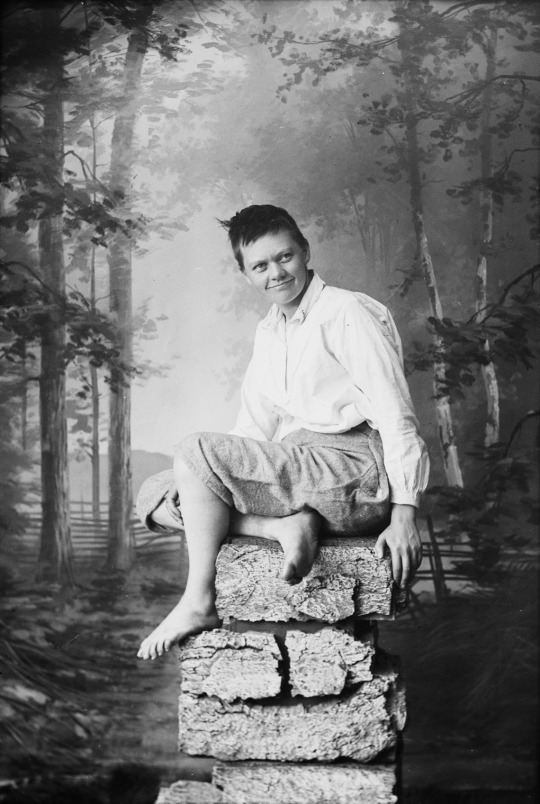
Marie Høeg as a young boy / view & read more on wordPress

Marie Høeg (in underwear) as a young boy with cigarette. Photo: Berg & Hoeg, ca. 1895-1903. | src The Preus museum collection on Flickr
view & read more on wordPress
#Berg and Hoeg#gender roles#gender identity#cross dressing#private photos#Berg and Høeg#Bolette Berg#staged photos#glass negative#glass plate negative#lesbian#lesbianism#LGBT#Marie Høeg#Marie Hoeg#1890s#cross-dressing#norwegian photographer#photographers photographed#damaged glass plate#queer#women artists#1900s#women photographers#sapphic#lgbtqia
130 notes
·
View notes
Text

Marie Høeg, by Berg & Hoeg, ca. 1895-1903, from the Preus museum collection
"Marie Hoeg sits crossed-legged in her underwear, with her initials on the collar. Her hair is short, her gaze is strong, and the cigarette is dangling."
#Marie Høeg#photography#the preus museum#antique#vintage#aesthetic#dark academia#light academia#historical photography#norway#1800s#1900s#19th century#20th century#history
114 notes
·
View notes
Photo

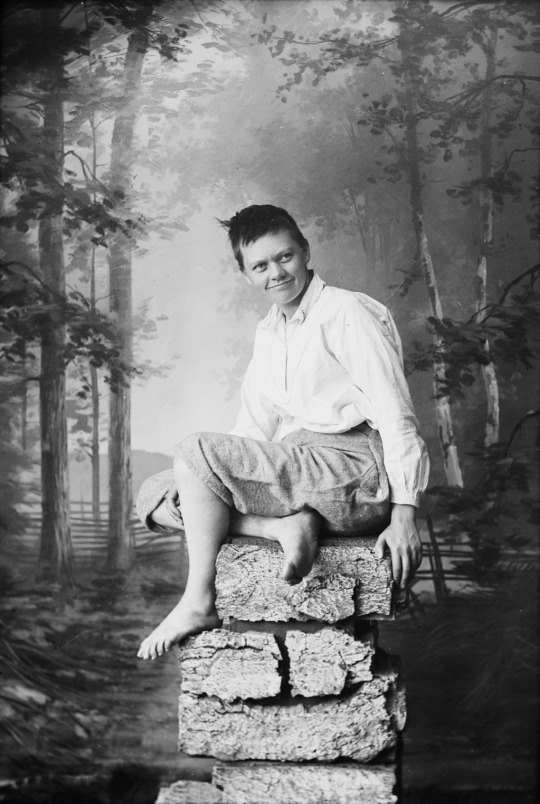

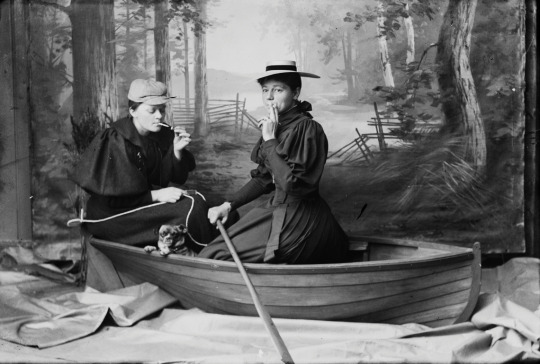
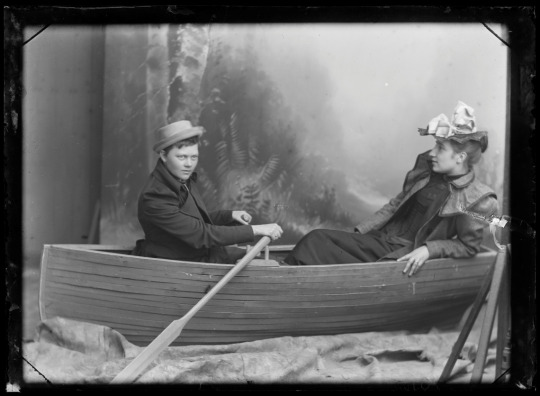
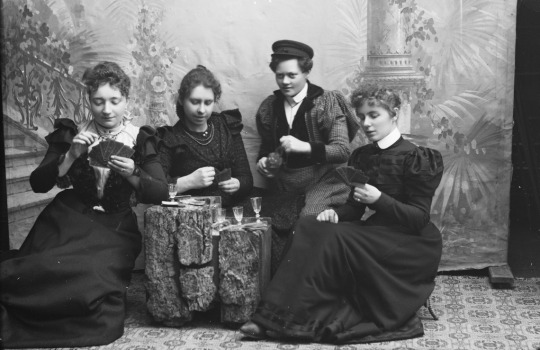
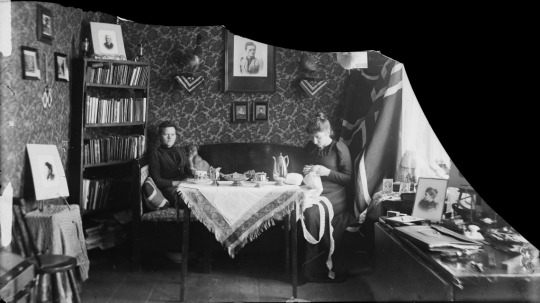
Marie Høeg (15 April 1866 – 22 February 1949) was a Norwegian photographer and suffragist. Høeg's published work was traditional in nature, while her private photography, including images of and created with her partner, Bolette Berg, challenged ideas of gender. She was the founder of the Horten Discussion Association, which is still active today. Høeg also started the Horten Branch of the National Association for Women's Right to Vote, the Horten Women's Council and the Horten Tuberculosis Association.
Høeg was born in Langesund on 15 April 1866. She was a photography student in Brevik and completed her photography apprenticeship in 1890.
From 1890 to 1895, Høeg lived in Finland, working as a photographer in Ekenäs and Hanko. Here, she was greatly influenced by the Finnish women's rights movement.
Høeg moved from Finland to Horten in 1895 together with Bolette Berg. Berg was five years younger than Høeg and had trained as a photographer, probably while living in Finland. Høeg and Berg set up and ran their own photography studio, which was named Berg & Høeg. Høeg used their studio not only for photography, but also as a meeting place for women interested in feminism and women's suffrage.
Høeg and Berg moved to Kristiania (present-day Oslo) in 1903 and continued working as professional photographers there, mostly producing scenic and portrait post cards.
The two founded the publishing company Berg og Høghs Kunstforlag A.S., publishing books such as the three-volume Norske Kvinder, which concerns the topic of the history of Norwegian women.
Marie Høeg died in Oslo on 22 February 1949.
Many of her glass negatives were discovered after her death inside a barn in the 1980s. The barn was on the property of a farm where Berg and Høeg lived at the end of their lives. A series of negatives in a box labelled "private" contained photographs of Berg and Høeg dressed in men's clothes, smoking, and wearing mustaches. These 440 glass negatives are now in the collection of the Preus Museum in Horten, Norway.
More here
#marie høeg#transgender history#lgbtq#women's suffrage#women's rights#lesbian history#cross dressing
383 notes
·
View notes
Photo

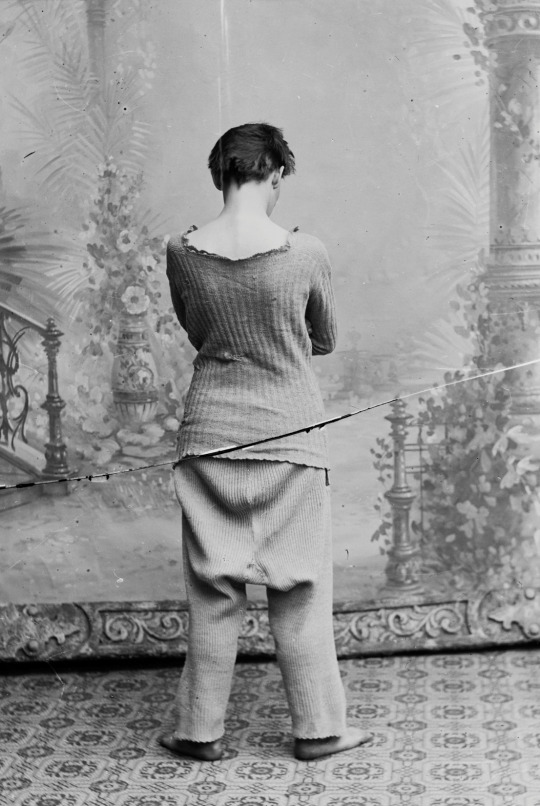
Marie Høeg casually posing in her woolen underwear. She looks self-confident in front of the camera. Possibly, her companion Bolette Berg is the photographer behind the camera. ca. 1895-1903
40 notes
·
View notes
Photo

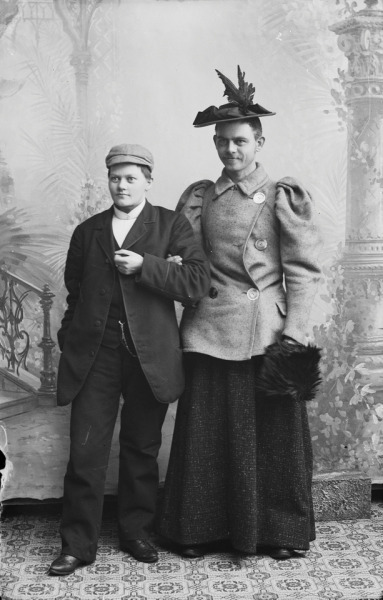
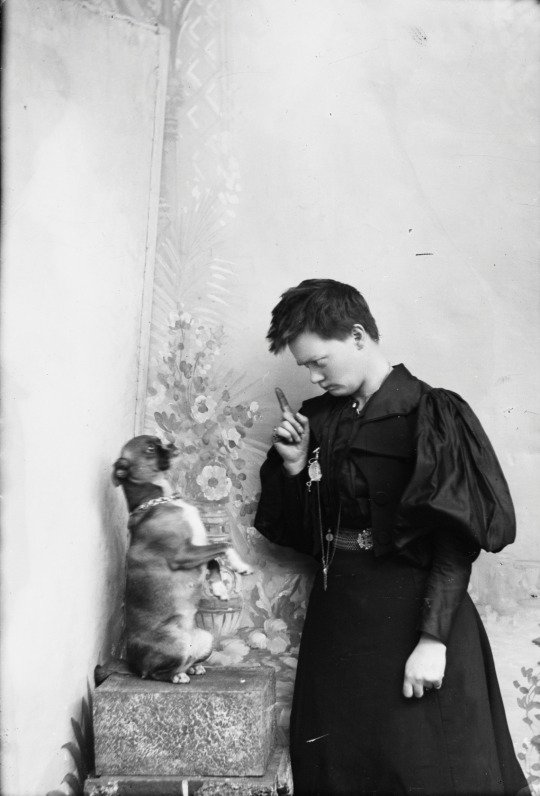


Queer artists 01/30 - Marie Høeg and Bollette Berg
In 1896, Marie Høeg and Bolette Berg opened a photography studio in Horten, Norway. The studio became a meeting place for feminist and suffrage groups and Marie and Bolette were involved in the founding of the Horten branch of the National Association for Women’s Right to Vote and the Horten Discussion Association. Marie and Bolette moved to Oslo in 1903 and continued to live together for many years. Their photography studio was expanded into a publishing house, which focused on books about women in Norway. They eventually bought and retired to a farm together. Bolette died in 1944, and Marie five years later, in 1949.
That was the end of Marie and Bolette’s story until, in the 1980s, a box was found in a barn on their farm. The box was labelled “private” and contained 440 glass negatives. While their professional photographic work had focused on very traditional portraits and landscapes, the pictures in this box showed Marie, Bolette and their friends playing with gender roles, with men in dresses and women undertaking traditionally masculine activities like drinking and playing cards.
It seems like Bolette was often the one behind the camera, so Marie is the subject of most of the photos - sometimes alongside the pair’s dog, Tuss. The final photo here, though, is thought to be of both Marie (left) and Bolette (right), posing as suitors in a rowboat together.
All these photos are now in the Preus Museum, in Norway, and you can check out a bunch of them online.
[Image description: Three women in dresses and Marie in a suit sit around a low table playing cards; Marie wears a suit and stands next to a man wearing a dress; Marie faces a dog on its hind legs, with one finger raised and a stern expression; Marie faces the camera, wearing a loose shirt and pants, and pulls a funny face; Marie, dressed in a suit, sits in a rowboat facing a woman in a dress.]
122 notes
·
View notes
Text
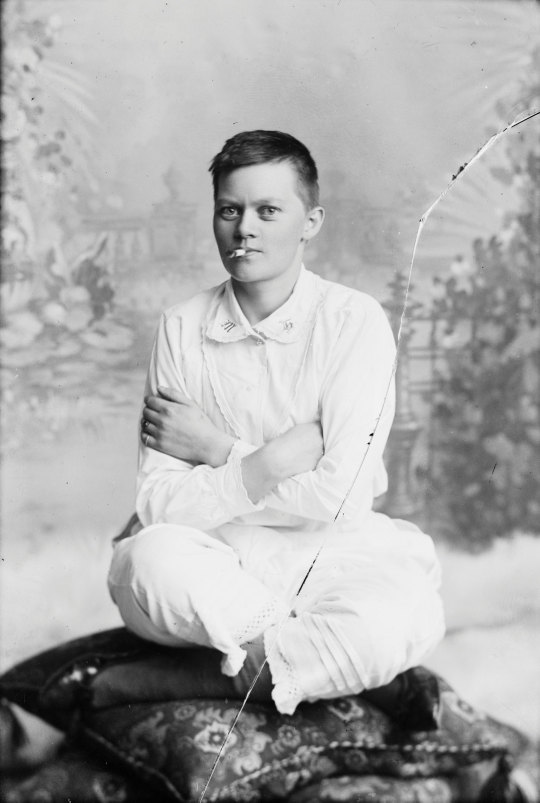
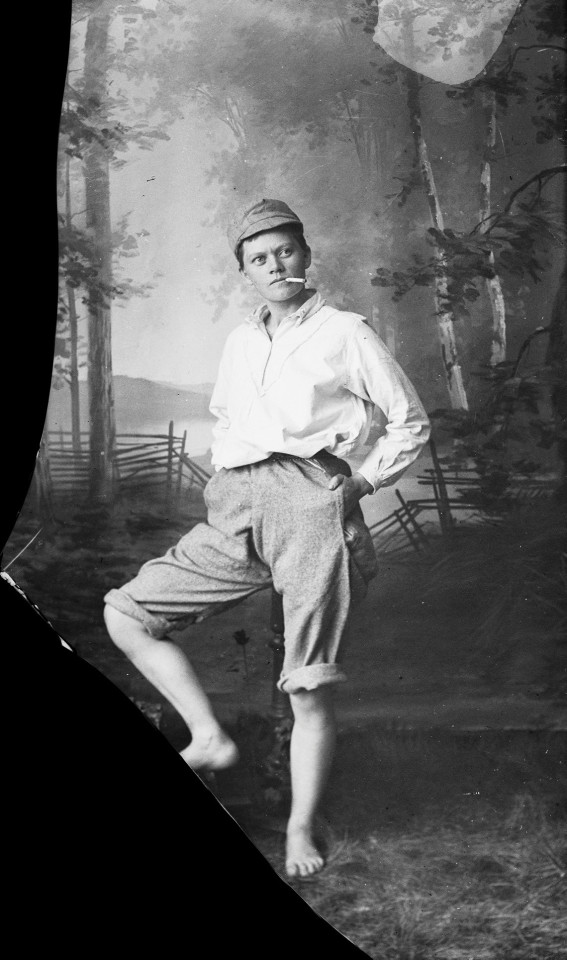
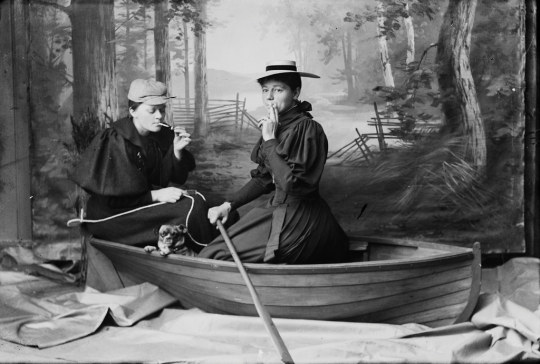
Photos from a private stash of pictures taken at a Norwegian portrait studio owned by Marie Høeg and Bolette Berg, ca. 1900. Høeg, who appears in the photos, sometimes in men's clothing, was a campaigner for women's rights in her country.
{WHF} {Ko-Fi} {Medium}
94 notes
·
View notes
Text
30 notes
·
View notes
Photo

Berg & Høeg (Horten)
Bolette Berg (Norwegian, 1872-1944)
Marie Høeg (Norwegian, 1866-1949)
Untitled [Marie Høeg and her brother in the studio]
c. 1895-1903
Owner: Preus Museum Collection, Norway
Art Blart
70 notes
·
View notes
Text
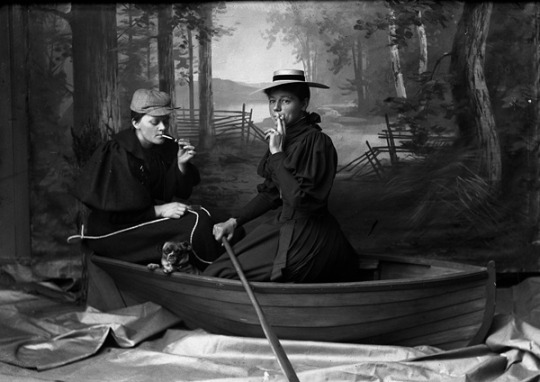
Self-portrait smoking by Marie Høeg (left) and her partner Bolette Berg (1895 – 1903)
16 notes
·
View notes
Text
Berg and Høeg lived life on their own terms, both as romantic partners in a time of little LGBTQ visibility and as business partners running a studio and publishing company when women were highly restricted in their careers — and beyond. But decades after their deaths in the 1940s, another radical aspect of their lives resurfaced, tucked away in boxes of glass negatives marked “private”: the couple eschewing traditional gender norms in playful portraits they took of themselves and loved ones.
3 notes
·
View notes
Text
“Private” de dos fotógrafas noruegas: Marie Høeg y Bolette Berg.
“Private” de dos fotógrafas noruegas: Marie Høeg y Bolette Berg
Texto: Satoru Yamada
(AICA y AECA)
Fotografía: Peter Wall
(AMCA)
Tiene un gran interés esta exposición de dos fotógrafas noruegas, recién inaugurada, en la Sala Minerva del Círculo de Bellas Artes de Madrid. No las conocía. Los modelos son obviamente mujeres, pero disfrazadas de hombre. Una lleva gorra de plato, abrigo gordo y…

View On WordPress
0 notes
Text
Queer Calendar 2023
We put together a calendar of key (mostly queer) dates at the start of the year to help us with scheduling - so I thought I’d share it around! Including pride and visibility days, some queer birthdays and anniversaries, and a few other bits and bobs. Click the links for more info - I dream one day of having a queer story for every day of the year!
This is obviously not an exhaustive list - if I’ve overlooked something important to you, feel free to add it in the reblogs!
January
3 - Bisexual American jazz-age heiress Henrietta Bingham born 1901
8 - Queer Australian bushranger Captain Moonlite born 1845; gay American art collector Ned Warren born 1860
11 - Pennsylvania celebrates Rosetta Tharpe Day in honour of bisexual musician Rosetta Tharpe
12 - Japanese lesbian author Nobuko Yoshiya born 1896
22 - Lunar New Year (Year of the Rabbit)
24 - Roman emperor Hadrian, famous for his relationship with Antinous, born 76CE; gay Prussian King Frederick the Great born 1712
27 - International Holocaust Remembrance Day
February
LGBT+ History Month (UK, Hungary)
Black History Month (USA and Canada)
1 - Feast of St Brigid, a saint especially important to Irish queer women
5 - Operation Soap, a police raid on gay bathhouses in Toronto, Canada, spurs massive protests, 1981
7 - National Black HIV/AIDS Awareness Day (USA)
18 - US Black lesbian writer and activist Audre Lorde born 1934
12 - National Freedom to Marry Day (USA)
19-25 - Aromantic Spectrum Awareness Week
March
Women’s History Month
1 - Black Women in Jazz and the Arts Day
8 - International Women’s Day
9 - Bi British writer David Garnett born 1892
12 - Bi Polish-Russian ballet dancer Vaslav Nijinsky born 1889 or 1890
13 March-15 April - Deaf History Month
14 - American lesbian bookseller and publisher Sylvia Beach born 1887
16 - French lesbian artist Rosa Bonheur born 1822
20 - Bi US musician Rosetta Tharpe born 1915
21 - World Poetry Day
24 - The Wachowski sisters’ cyberpunk trans allegory The Matrix premiers 1999
April
Jazz Appreciation Month
Black Women’s History Month
National Poetry Month (USA)
3 - British lesbian diarist Anne Lister born 1791
8 - Trans British racing driver and fighter pilot Roberta Cowell born 1918
9 - Bi Australia poet Lesbia Harford born 1891; Easter Sunday
10 - National Youth HIV & AIDS Awareness Day (USA)
14 - Day of Silence
15 - Queer Norwegian photographer and suffragist Marie Høeg born 1866
17 - Costa-Rican-Mexican lesbian singer Chavela Vargas born 1919
21-22 - Eid al-Fitr
25 - Gay English King Edward II born 1284
26 - Lesbian Day of Visibility; bi American blues singer Ma Rainey born 1886
29 - International Dance Day
30 - International Jazz Day
May
1 - Trans British doctor and Buddhist monk Michael Dillon born 1915
7 - International Family Equality Day
7 - Gay Russian composer Pyotr Tchaikovsky born 1840
15 - Australian drag road-trip comedy The Adventures of Priscilla, Queen of the Desert premiers in 1994
17 - IDAHOBIT (International Day Against Homophobia, Biphobia, Intersexism and Transphobia)
18 - International Museum Day
19 - Agender Pride Day
22 - US lesbian tailor and poet Charity Bryant born 1777
22 - Harvey Milk Day marks the birth of gay US politician Harvey Milk 1930
23 - Premier of Pride, telling the story of the 1980s British activist group Lesbians and Gays Support the Miners
24 - Pansexual and Panromantic Awareness and Visibility Day; Queer Chinese-Japanese spy Kawashima Yoshiko born 1907
26 - queer American astronaut Sally Ride born 1951
29 - Taiwanese lesbian writer Qiu Miaojin born 1969
June
Pride Month
Indigenous History Month (Canada)
3 - Bisexual American-French performer, activist and WWII spy Josephine Baker born 1906
5 - Queer Spanish playwright and poet Federico García Lorca born 1898; bi English economic John Maynard Keynes born 1883
8 - Mechanic and founder of Australia’s first all-female garage, Alice Anderson, born 1897
10 - Bisexual Israeli poet Yona Wallach born 1944
12 - Pulse Night of Remembrance, commemorating the 2012 shooting at the Pulse nightclub, Orlando
14 - Australian activists found the Gay and Lesbian Kingdom of the Coral Sea Islands in 2004
18 - Sally Ride becomes the first know queer woman in space
24 - The first Sydney Mardi Gras 1978
25 - The rainbow flag first flown as a queer symbol in 1978
28 - Stonewall Riots, 1969
28 June-2 July - Eid al-Adha
30 - Gay German-Israeli activist, WWII resistance member and Holocaust survivor Gad Beck born 1923
July
1 - Gay Dutch WWII resistance fighter Willem Arondeus killed - his last words were “Tell the people homosexuals are no cowards”
2-9 - NAIDOC Week (Australia) celebrating Aboriginal and Torres Strait Islander culture
6 - Bi Mexican artist Frida Kahlo born 1907
12 or 13 - Roman emperor Julius Caesar born c.100BCE
14 - International Non-Binary People’s Day
23 - Shelly Bauman, owner of Seattle gay club Shelly’s Leg, born 1947; American lesbian cetenarian Ruth Ellis born 1899; gay American professor, tattooist and sex researcher Sam Steward born 1909
25 - Italian-Australian trans man Harry Crawford born 1875
August
8 - International Cat Day
9 - Queer Finnish artist, author and creator of Moomins Tove Jansson born 1914
9 - International Day of the World's Indigenous Peoples
11 - Russian lesbian poet Sofya Parnok born 1885
12 - Queer American blues musician Gladys Bentley born 1907
13 - International Left-Handers Day
22 - Gay WWII Dutch resistance fight Willem Arondeus born 1894
24 - Trans American drag queen and activist Marsha P Johnson born 1945
26 - National Dog Day
30 - Bi British author Mary Shelley 1797
31 - Wear it Purple Day (Australia - queer youth awareness)
September
5 - Frontman of Queen Freddie Mercury born 1946
6 - Trans Scottish doctor and farmer Ewan Forbes born 1912
13 - 1990 documentary on New York’s ball culture Paris is Burning premiers
15-17 - Rosh Hashanah
16-23 - Bisexual Awareness Week
17 - Gay Prussian-American Inspector General of the US Army Baron von Steuben born 1730
23 - Celebrate Bisexuality Day
24 - Gay Australian artist William Dobell born 1889
30 - International Podcast Day
October
Black History Month (Europe)
4 - World Animal Day
5 - National Poetry Day (UK)
5 - Queer French diplomat and spy the Chevalière d’Éon born 1728
8 - International Lesbian Day
9 - Indigenous Peoples’ Day (USA)
11 - National Coming Out Day
16 - Irish writer Oscar Wilde born 1854
18 - International Pronouns Day
22-28 - Asexual Awareness Week
26 - Intersex Awareness Day
31 - American lesbian tailor Sylvia Drake born 1784
November
8 - Intersex Day of Remembrance
12 - Diwali; Queer Mexican nun Sor Juana Inés de la Cruz born c.1648
13-19 - Transgender Awareness Week
20 - Trans American writer, lawyer, activist and priest Pauli Murray born 1910; Transgender Day of Remembrance
27 - Antinous, lover of the Roman emperor Hadrian, born c.111; German lesbian drama Mädchen in Uniform premiers, 1931
29 - Queer American writer Louisa May Alcott born 1832
December
AIDS Awareness Month
1 - World AIDS Day
2 - International Day for the Abolition of Slavery
3 - International Day of Persons with Disabilities
8 - Pansexual Pride Day; queer Swedish monarch Christina of Sweden born 1626
10 - Lesbians and Gays Support the Miners host Pits and Perverts concern to raise mining for striking Welsh miners, 1984
14 - World Monkey Day
15 - Roman emperor Nero born 37CE
24 - American drag king and bouncer Stormé DeLarverie born 1920
25 - Christmas
29 - Trans American jazz musician Billy Tipton born 1914
#calendar#queer calendar#queer observances#pride days#queer history#lgbt#lgbtq#lgbt history#gay history#trans history#queer#gay#trans#lesbian#lesbian history
252 notes
·
View notes
Text
Berg and Høeg lived life on their own terms, both as romantic partners in a time of little LGBTQ visibility and as business partners running a studio and publishing company when women were highly restricted in their careers — and beyond. But decades after their deaths in the 1940s, another radical aspect of their lives resurfaced, tucked away in boxes of glass negatives marked “private”: the couple eschewing traditional gender norms in playful portraits they took of themselves and loved ones.
1 note
·
View note
Text

Marie Høeg - Self-portrait with Bolette Berg (c. 1895-1903)
0 notes
Text
The Female Gaze: Exposing The Other History of Photography
This new book focuses on giving pioneering women photographers their place in the annals of the art. Words by Chloë Ashby
About two-thirds of the way through her engaging new book, Emma Lewisdescribes the subtle yet significant distinction between ‘seeing’ and ‘looking’. Photographic theory, she writes, has typically focused on the latter, which positions “making or regarding photographs as an acquisitive act, and the subject as a spectacle”. Bringing ‘seeing’ into the equation introduces a different dynamic: “It suggests that behind the act of photographing is an intention to understand and, perhaps by extension, a will to help the viewers themselves feel understood.”You could say that Photography: A Feminist History shares the same intention. Flick back to the introduction and Lewis (an assistant curator of international art at Tate Modern) acknowledges attempts to restore women’s names into the history of photography. But she asks, beyond the “genteel lady hobbyists” and the “gung-ho pioneers”, where are “the working-class women who set up studios to make ends meet” and “the ordinary folk quietly recording their communities because they knew that no one else would”?
It’s the stories of these photographers (each of whom identifies as a woman, trans or gender nonconforming) that Lewis sheds light on. The stories that didn’t make it into the traditional account of photography because they didn’t fit with the neat and tidy definition of history and progress.
Photography: A Feminist History is an account of roughly 200 years of photography told from a feminist perspective. Divided into ten chapters, it charts the landmarks in photography and women’s rights, culture and politics, as well as how they have overlapped and shaped the images photographers have taken and our interpretation of them.It would be easy for a book structured in such a way, by thematic essays and profiles, to feel choppy and rushed, but this one is nothing if not considered. From documentary photography and art as activism to the family album and social media, Lewis thoughtfully maps photographic developments and “the messy business of feminism”.
“For many of the individuals in this book, producing images was a means of understanding who they were and their place in the world”
The profiles see Lewis zoom in on 75 key practitioners. Early on we read of Bolette Berg and Marie Høeg, who ran a successful photography studio in Oslo in the early 20th century, and whose private portraits provide insight into their beliefs surrounding gender, sexuality, and conformity. Then there’s Florestine Collins, who began taking photographs in 1909 at the age of 14 to support her family and went on to open a studio from her living room (in part to avoid becoming a servant for white families and enduring long hours, poor pay and the threat of harassment).
While many chose not to emphasise their gender in their images, some forms of photography were particularly suited to tackling it, not least photomontage. Together with Lee Miller and Cindy Sherman, Hannah Höch is among the more familiar names found within the pages of the book. The Dadaists used the technique of fragmentation to critique the commodification of women’s bodies: “By depicting female bodies only in parts (a gymnast’s torso, a model’s stocking-clad legs, a mother’s arms cradling a baby) they drew attention to the multiple identities that women ‘should’ occupy as healthy, productive citizens, sex objects and nurturers.”
Each character study is accompanied by an image, and a highlight is Lucia Moholy’s portrait of her then-husband, Hungarian painter and photographer László Moholy-Nagy. The black-and-white photograph blurs out his palm, which is raised in front of the lens, and focuses on his bespectacled, smiling face, a mix of highlights and shadows.
As Lewis writes: “It is not only an illustration of how the camera can compress depth but is also, perhaps, symbolic: his gesture dismissive, pushing her away while pulling him into focus.” The work Moholy did on the couple’s photograms and texts went unacknowledged until she revealed the true nature of their collaborative relationship in Moholy-Nagy, Marginal Notes (1972).
For many of the individuals in this book, producing images was a means of understanding who they were and their place in the world. Joan E Biren, known as JEB, taught herself photography because, as Lewis writes, she had a “visceral” need to see a reflection of her reality. The first image she ever saw of two women kissing was the one she took of herself and her lover, Sharon.“I wanted to see it,” she said.
Finnish photographer Elina Brotherus’s autobiographical series Annonciation (2009-13) sets out to counter the lack of visibility around infertility, while Dutch artist Rineke Dijkstra’s frank yet tender series New Mothers (1994) shows the often-harsh realities of motherhood.
Of course, photography has its limits, and shortly after describing that subtle yet significant distinction between ‘seeing’ and ‘looking’, Lewis quotes the cultural critic and public intellectual Susan Sontag: “Life is not about significant details, illuminated in a flash, fixed forever. Photographs are.” And so, Lewis asks, how do we reconcile these limitations with the responsibilities of the photographer and the viewer towards the subject?
Like the business of feminism, the answer is sprawling and complex. But this book offers clear and cogent guidance by encouraging us to “not simply look at the photograph, or indeed its maker, but instead to try and see”.
https://elephant.art/the-female-gaze-exposing-the-other-history-of-photography-17102021/
1 note
·
View note
